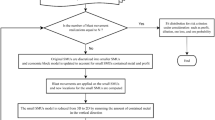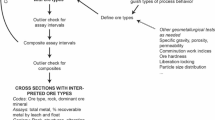Abstract
For every blast pattern, zones of unique material types need to be classified before mining. Most material types can be summarized into different kinds of ore and waste. Blocks generated from blasthole assays are too small to be selectively mined so areas with a single material classification meeting the mine’s selective mining unit must be defined. Current industry standard practices are to manually draw ore/waste dig limits but this process is subjective and results in quantities of dilution and ore loss which can be improved upon to enhance the profitability of mining operations. Two weeks production data from a homogeneous Cu porphyry and heterogeneous Manto-type Cu deposit are used to assess the variability in the hand-drawn dig limits for 20 geologists, mining engineers, or ore control specialists and are compared with the optimal ore/waste delineation. The profit for 20 distinct hand-drawn dig limits for the homogeneous mine ranged by 3.7% from $10.5 million to $10.9 million averaging at $10.8 million. The percent range nearly doubled for the more heterogeneous mine at 5.9% from $17.9 million to $19.0 million averaging at $18.6 million. Using the optimal ore waste delineation, the profit increased to $11.0 million (1.9% increase) and $19.3 million (7.0% increase) for the homogeneous and heterogeneous deposits respectively. The natural variability, diggability requirement, and selectivity are identified as the main drivers of ore loss and dilution. Recommendations are provided for reducing the subjectivity in manual hand-drawn dig limits by integrating dig limit optimization algorithms as a tool to assist practitioners.












Similar content being viewed by others
References
Calvo G, Mudd G, Valero A, Valero A (2016) Decreasing ore grades in global metallic mining: a theoretical issue or a global reality? Resources 5(4):36. https://doi.org/10.3390/resources5040036
Parker HM (2012) Reconciliation principles for the mining industry. Min Technol 121(3):160–176
Gruenhagen JH, Parker R (2020) Factors driving or impeding the diffusion and adoption of innovation in mining: a systematic review of the literature. Resour Policy 65:101540. https://doi.org/10.1016/j.resourpol.2019.101540
Ediriweera A, Wiewiora A (2021) Barriers and enablers of technology adoption in the mining industry. Resour Policy 73:102188. https://doi.org/10.1016/j.resourpol.2021.102188
Blom M, Pearce AR, Stuckey PJ (2019) Short-term planning for open pit mines: a review. Int J Min Reclam Environ 33(5):318–339. https://doi.org/10.1080/17480930.2018.1448248
Câmara TR, Leal RS, Peroni RDL, Capponi LN (2019) Controlling operational dilution in open-pit mining. Min Technol 128(1):1–8. https://doi.org/10.1080/25726668.2018.1470275
Norrena K, Deutsch CV (2000) Automatic determination of dig limits subject to geostatistical, economical and equipment constraints. Center for Computational Geostatistics (CCG), University of Alberta, Edmonton, Alberta, Canada. https://www.ccgalberta.com/ccgresources/report03/2001-114_dig_limits.pdf
Norrena KP, Deutsch CV (2002) Optimal determination of dig limits for improved grade control. In APCOM 2002: 30th International Symposium on the Application of Computers and Operations Research in the Mineral Industry 329–339
Isaaks E, Treloar I, Elenbaas T (2014) Optimum dig lines for open pit grade control. In 9th International mining geology conference, Adelaide, South Australia
Ruiseco JR, Williams J, Kumral M (2016) Optimizing ore–waste dig-limits as part of operational mine planning through genetic algorithms. Nat Resour Res 25:473–485. https://doi.org/10.1007/s11053-016-9296-1
Ruiseco JR, Kumral M (2017) A practical approach to mine equipment sizing in relation to dig-limit optimization in complex orebodies: multi-rock type, multi-process, and multi-metal case. Nat Resour Res 26:23–35. https://doi.org/10.1007/s11053-016-9301-8
Tabesh M, Askari-Nasab H (2013) Automatic creation of mining polygons using hierarchical clustering techniques. J Min Sci 49:426–440. https://doi.org/10.1134/S1062739149030106
Richmond A (2004) Integrating multiple simulations and mining dilution in open pit optimisation algorithms. In: Orebody modelling and strategic mine planning conference. https://martlet.com.au/wp-content/uploads/2020/11/2004_ARichmond_SMP2004_Integrating-Multiple-Simulations-and-Mining-Dilution-in-Open-Pit-1.pdf
Richmond AJ, Beasley JE (2004) Financially efficient dig-line delineation incorporating equipment constraints and grade uncertainty. Int J Surf Min 18(2):99–121. https://doi.org/10.1080/13895260412331295376
Kumral M (2015) Grade control in multi-variable ore deposits as a quality management problem under uncertainty. Int J Qual Reliab Manage 32(4):334–345. https://doi.org/10.1108/IJQRM-08-2013-0134
Sari YA, Kumral M (2017) Dig-limits optimization through mixed-integer linear programming in open-pit mines. J Oper Res Soc 69(2):171–182. https://doi.org/10.1057/s41274-017-0201-z
Williams J, Singh J, Kumral M, Ramirez Ruiseco J (2021) Exploring deep learning for dig-limit optimization in open-pit mines. Nat Resour Res 30:2085–2101. https://doi.org/10.1007/s11053-021-09864-y
Vasylchuk YV (2019) Advanced grade control with multivariate geostatistics, blast movement modeling, and optimized dig limits. https://doi.org/10.7939/r3-5qkm-r822
Hmoud S, Kumral M (2022) Effect of blast movement uncertainty on dig-limits optimization in open-pit mines. Nat Resour Res 31(1):163–178. https://doi.org/10.1007/s11053-021-09998-z
Dominy SC (2014) Predicting the unpredictable—evaluating high-nugget effect gold deposits. Mineral Resource and Ore Reserve Estimation; Australasian Institute of Mining and Metallurgy. Melbourne, Australia, pp 659–678. http://cdn.ceo.ca.s3-us-west-2.amazonaws.com/1esojp7-2014_D_NuggetevaluationMONO30%20%281%29.pdf
Li Y, Sepúlveda E, Xu C, Dowd P (2021) A rapid updating method to predict grade heterogeneity at smaller scales. Math Geosci 53(6):1237–1260. https://doi.org/10.1007/s11004-020-09901-1
Heriawan MN, Koike K (2008) Identifying spatial heterogeneity of coal resource quality in a multilayer coal deposit by multivariate geostatistics. Int J Coal Geol 73(3–4):307–330. https://doi.org/10.1016/j.coal.2007.07.005
Afonseca BC, Miguel-Silva V (2022) Defining optimal drill-hole spacing: a novel integrated analysis from exploration to ore control. J South Afr Inst Min Metall 122(6):305–315
Toconasa F, Jordanb LS, Keddac S (2022) A comparison between conventional blast hole sampling and diamond core drilling for copper grade at the Antapaccay mine. In TOS forum 1(11):325–337. IM Publications Open. https://www.impopen.com/subs/tosf/v22/S11_0325.pdf
Parker HM (1980) The volume-variance relationship: a useful tool for mine planning, in Geostatistics, p 61–91, McGraw-Hill
Rossi ME, Parker HM (1994) Estimating recoverable reserves: is it hopeless. Geostat Next Century 6:259–276
Faraj F, Ortiz JM, Arnal J (2022) Data driven approaches for estimating bulk ore sorting value, predictive geometallurgy and geostatistics lab, queen’s university, annual report 2022, paper 2022–07, 96–118. https://geomet.engineering.queensu.ca/wp-content/uploads/2022-07-Faraj-Bulk-Ore-Sorting-web.pdf
Balamurali M (2022) A Bayesian method for estimating uncertainty in excavated material. Int J Min Reclam Environ 36(2):125–141. https://doi.org/10.1080/17480930.2021.1992103
Neufeld CT, Norrena KP, Deutsch CV (2003) Semi-automatic dig limit generation. In: Proceedings of the 5th CCG Annual Conference. University of Alberta, AB, Canada. https://ccg-server.engineering.ualberta.ca/CCG%20Publications/CCG%20Annual%20Reports/Report%205%20-%202003/26-diglim.pdf
Isaaks E (2015) What is digger? Specialists in spatial statistics (1–10). https://dokumen.tips/documents/what-is-digger.html?
Acknowledgements
Isabel Cumming, Jose Arnal, and Stewart Langley are acknowledged for their contributions to the paper.
Author information
Authors and Affiliations
Corresponding author
Ethics declarations
Competing Interests
The author declares no competing interests.
Additional information
Publisher's Note
Springer Nature remains neutral with regard to jurisdictional claims in published maps and institutional affiliations.
Rights and permissions
Springer Nature or its licensor (e.g. a society or other partner) holds exclusive rights to this article under a publishing agreement with the author(s) or other rightsholder(s); author self-archiving of the accepted manuscript version of this article is solely governed by the terms of such publishing agreement and applicable law.
About this article
Cite this article
Faraj, F. Assessing Dilution, Ore Loss, and Profit Differences from Various Hand-Drawn Dig Limits Compared to Optimal Ore-Waste Delineations in Deposits of Variable Heterogeneity. Mining, Metallurgy & Exploration 41, 707–718 (2024). https://doi.org/10.1007/s42461-024-00944-0
Received:
Accepted:
Published:
Issue Date:
DOI: https://doi.org/10.1007/s42461-024-00944-0




